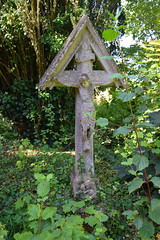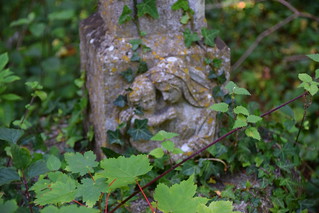Eye Borough Cemetery is a
small and delicious burial ground at the
edge of the town on the road to the
Thornhams. The cemetery was opened in
response to the closure of urban
churchyards legislation in the 1850s, a
mark that until fairly recently Eye was
considered on a par with the county's
larger towns. The twin chapels, both
simple, even prosaic, sit to east and
west of each other, that to the west now
closed and used for storage, the east
chapel maintained in the High Anglican
tradition and open every day. It is
furnished by a set of what appear to be
oversized choir stalls, which presumably
came from elsewhere, and a seemly-dressed
altar with candles burning in front of
it. I liked it very much.
I'd really only come here as a result of
a conversation I'd had with a man in Eye
church. He told me that there was a
headstone in the cemetery which had been
designed by Sir Ninian Comper, the great
early 20th Century church artist. Comper
had been a close friend of the Tacon
family of Brome Hall, and Maude Tacon was
the patroness of Eye church. She
bankrolled the fabulous Anglo-Catholic
makeover of the church in the 1920s and
1930s, mostly the work of Comper, in
cooperation with the parish priest John
Polycarp Oakey. It so happened that Oakey
was also Tacon's lover, and the east
window by Comper in Eye church is her
tribute to him, depicting him kneeling at
the feet of his patron saint.
Parts of the cemetery had been left as a
conservation area, which was wildly
overgrown after one of the wettest
winters and hottest summers on record. I
searched the rest of the cemetery first,
but it soon became clear to me that this
would be where Maude Tacon was buried.
Pushing my way through the rich
undergrowth, receiving plenty of nettle
stings, lifting low boughs to peep
underneath, I was eventually able to get
close to four large memorials huddled
behind a clump of yews, and as you can
imagine I was excited to discover that
they were to members of the Tacon family.
Among them I quickly found Comper's
headstone to Maude Tacon, a typical
Comper crucifixion with Christ's young
head lolling, and at the foot of the
cross a delightful Madonna and child.
Tacon died in 1953, by which time Comper
was 89 (he lived to be 96), but I expect
it was actually based on earlier designs
by Comper, who had a fair few
crucifixions to his name over the years.  
It was satisfying to be able
to find the headstone I had come looking
for, but I was also able to pay my
respects to Edward Catchpole, who died in
1890 and was an honest and faithful
servant of the public whom he served for
56 years: by his death the last of the
Common Stage Waggoners became extinct
from Palgrave, Suffolk. Catchpole's
name and trade instantly recalled the
much better-known memorial to John
Catchpole, his great-grandfather, in
Palgrave churchyard, which depicts in
relief the Palgrave stage waggon in full
flight behind horses.
Not far from Edward
Catchpole lies Thomas Tuffs, who in 1892
was remembered as for 30 years rural
postman from Eye to Gislingham, and
also Caroline Smith, who at her death in
1890 had been for four years
Housekeeper of Mr G Day of this town. Presumably
he paid for her headstone, as a good
master no doubt should.
|

